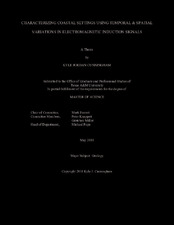| dc.description.abstract | Electromagnetic induction (EMI) methods have long been used to explore and analyze near-surface geological and hydrological components of coastal systems. However, there have been few studies that use EMI to analyze the spatiotemporal hydrodynamics of coastal systems and its relationship to the underlying framework geology. Here the objectives are to investigate the tidal influence on hydrodynamics of coastal systems, compare results with those found in previous studies, and serve as a guide to the methodology and analysis techniques that can be utilized in similar studies and how to interpret the geophysical data. Analyzing the spatiotemporal hydrodynamics, through EMI signal variations, of two coastal settings, Sargent, TX and Matagorda, TX, gives useful information on how groundwater flow is influenced by tidal fluctuations. It has been observed in previous studies that while the tidal signature displays a sinusoidal pattern, the EMI data should follow and step-like function.
Time series and spatial profile data were collected using a portable multi-frequency profiler, at two sites within the Sargent site, the beach and a saltmarsh located on the other side of the Gulf Intercoastal Waterway, and at Matagorda beach. By collecting apparent conductivity measurements at a fixed location, time series data were obtained and then were compared to the appropriate tidal chart, giving information on how groundwater flows in relation to tidal variation. Spatial profiles were conducted in the Sargent saltmarsh and Matagorda beach locations to observe how apparent conductivity varies across the areas. Measurements for spatial profiles were collected twice along each transect.
Data was analyzed through several techniques. Plotting the apparent conductivity measurements from time series and spatial profile data, allows comparison to the tidal charts for EMI-tide correlations. Fourier and fractal analysis was conducted on spatial profiles only, in order to determine if the original signal can be classified as fractal-like and gain information about the heterogeneity of the subsurface. Lastly, wavelet analysis was applied as a pictorial way of analyzing how the wavenumber content of a signal varies along a profile.
After comparison with results from previous studies, it was found the results here are inclusive in observing a step-like function from the EMI signal data. This was caused from data sets being lost from instrument malfunction, and data being collected over a brief window of the tidal cycle. However, the data collection methods, analysis techniques, and interpretations of data utilized here, serve as an informative guide for future research in similar areas. | en |


